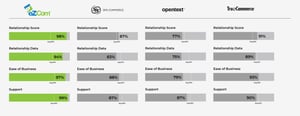If you are new to EDI, you’ll quickly learn that not all retail trading partners require the same documents. In fact, knowledge of the different retailer requirements is one reason partnering with an expert third-party EDI provider can be valuable. Just be sure to choose one that is constantly reviewing and updating their maps. One of the most utilized EDI documents goes by a few different names—the ASN or EDI 856 or the Shipment.
Under any name, the ASN is an extremely important document to both the supplier and the retailer. The purpose of the ASN is to communicate important details about the shipment that the trading partner will be receiving, such as when it will arrive, how it will get there, and what is included in the shipment.
The ASN can work in conjunction with GS1-128 labels, allowing the retailer to know exactly what is in each carton simply by scanning the barcode. When they scan the label, it will match to the ASN and the retailer will see the details about the carton contents, such as the product, color, size, weight, and quantity.
What’s the difference between the ASN and a Bill of Lading?
While some of the information on the ASN is similar to a Bill of Lading, such as the carrier, tracking information, weights and volume of the order, the ASN also provides detailed information about the contents of the shipment. The Bill of Lading accompanies the shipment, while the ASN is transmitted to the trading partner as soon as the goods leave the dock. As a result, the ASN can speed everything that happens throughout the process—from preparing the retailer to receive the shipment, getting the product on the shelf faster, and increasing the speed of the payment process.
Can I automate the ASN?
A powerful EDI platform will give you the option to automate the ASN. For instance, our Lingo software can create and/or transmit ASNs automatically. This is accomplished by presets that are entered into the account during setup, although they can be updated or changed at any time.
To automate the creation of the ASN, a tag defined in trading partner settings is applied to the order when it arrives. That tag triggers the automation process to begin. The ASN will be created and the relevant labels, Bill of Lading document, and Packing Slips will be emailed to the specified recipient(s).
The process can further be automated by having the ASNs transmitted automatically, based upon presets that establish the tag that will trigger the auto-send, as well as at what time(s) the document should be sent. Instead of going into the system and sending each ASN individually, Lingo handles it for our customers.
Can I connect the ASN to the Invoice?
Yes. It’s valuable to connect the ASN and the Invoice. This can also be set up in the System Settings in Lingo.
Once this is established, the system will automatically create the Invoice from the ASN when the document is sent. By connecting the Invoice to the ASN, brands and suppliers can be confident that the two documents will match precisely. That translates into faster reconciliation and payment by trading partners, and strengthens the business relationship because both parties have confidence that the information is correct.
Additionally, to fully automate the process, presets in the Invoice Automation section can be used so that the Invoice will be transmitted automatically at the established time in the settings.
Can I skip the ASN?
Uh, well, technically you can “skip” any EDI document. But you put your valuable trading partner relationships at risk when you do. By automating vital, standard documents such as the ASN, you ensure that you stay in compliance with retailers, create efficiency throughout the supply chain, and speed the payment process.
With a platform like Lingo, you can be confident that the ASN is sent automatically, and that all the necessary routing information is exchanged. By any name—the ASN or EDI 856 or the Shipment—this document is a key part of building productive retailer relationships.
Get the ASN right.
Most retailers require a specific set of EDI documents to be exchanged with each transaction. While the required documents will vary among different trading partners, the ASN is one document that is commonly utilized. It can be a time-intensive document when done manually, so automating the process can free up hours of valuable time.
Whether you call it the ASN or EDI 856 or the Shipment, handling the ASN as efficiently as possible and sending it out at the appropriate time provides benefits that include faster payments, fewer errors, and less time spent ensuring that data is accurate and matches the Invoice.






